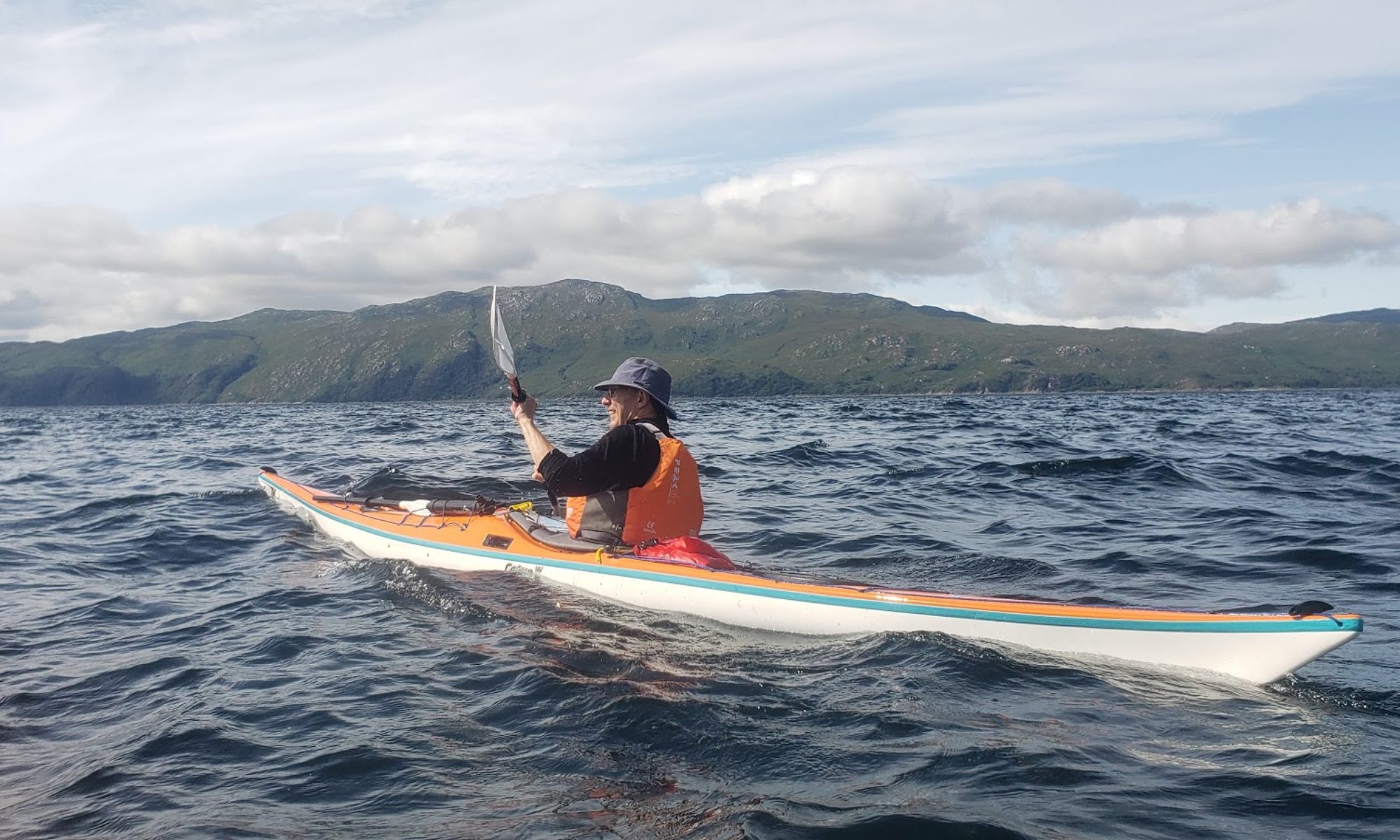Paddlers: M.M., Hugh and Geoff Weather: Very Mixed; Glorious Sunshine, Torrential Rain, Calm and Windy. Route:  Description: The remote Ardnumurchan peninsular is the most westerly place on the British mainland and rounding the headland is something of a target for all sea kayakers. Like all sea kayaking the feasibility is totally wind dependent and our conditions were excellent with a light southerly breeze and sunshine. We started towards the mouth of Loch Sunart at an easy launch point after a second car had been moved up to the finishing point on the other side of the peninsular. One of the difficulties is finding both camp sites and launch points and, in retrospect, a longer 4 day trip from Salen round to Ardtoe and Loch Moidart might have been better. The weather was overcast and the cliff scenery excellent. Two Sea Eagles circled overhead.
Description: The remote Ardnumurchan peninsular is the most westerly place on the British mainland and rounding the headland is something of a target for all sea kayakers. Like all sea kayaking the feasibility is totally wind dependent and our conditions were excellent with a light southerly breeze and sunshine. We started towards the mouth of Loch Sunart at an easy launch point after a second car had been moved up to the finishing point on the other side of the peninsular. One of the difficulties is finding both camp sites and launch points and, in retrospect, a longer 4 day trip from Salen round to Ardtoe and Loch Moidart might have been better. The weather was overcast and the cliff scenery excellent. Two Sea Eagles circled overhead.
Mingary Castle, which is found just before the village of Kilchoan, is the 13th century stronghold of the Clam McIain. It is owned by a Trust and is currently being restored with funds from the local landowner (Ardnumurchan Estates) and the National Lottery. When we arrived they had nearly completed scaffolding with scaffold poles and fittings made of stainless steel. When finished it will be a complete castle for let, presumably for historic weddings etc. Web sites (e.g. http://www.mingarycastletrust.co.uk/mingarycastletrust/) give lots more information.
We found a good campsite a km on with flat ground, a good supply of wood and no houses in the vicinity. During the evening the cloud lifted and although sea mist and fog was threatened none came over the camp site.



The mist that swirled around early on Thursday soon cleared and the sun soon illuminated the surrounds. A dominant feature of the trip was the high spring tide which generated very high highs and very low lows with a range of over 12 feet (4m). We originally intended to leave late to catch the north flowing tide but instead left early to ensure that we could float the boats from the beach, rather than carry them over slippy sharp rocks for 200m, In fact the south flowing tide had minimal impact relative to the southerly breeze that pushed us along a spectacular coastline towards the headland.

In a couple of hours we reached the headland and lighthouse.
The views were spectacular. Looking north Muck, Rhum and Eigg were in the foreground with the Cuillins of Skye and Knoydart as the background. To the far west the Outer Hebrides were just visible and in the south west stood Coll. On days like this, there is nowhere better scenically.

After a long lunch break and exploration of the lighthouse and facilities we retrieved the boats from where they had been marooned by the rapidly dropping tide and paddled over to investigate Sanna Bay and identify potential camp sites.

By this time the tide was very low and any camp site would have required a carry of several hundred metres, so we went on to assess another potential site around the headland. In this case the sand beach was protected by a minefield of sharp rocks; OK at half tide and above but impossible at the current state. On again to another sand beach but on this occasion the rocks lay between the sand and the potential site. However there were some deep caves, known as the Glendrian Caves, to explore.

After this interlude the hunt for a site was really on. On the map, about 1km on, a path was shown descending the cliffs and this was taken as a possible site. This proved correct although flat space was limited and firewood was non existent. However a fire was made using dried kelp and an enjoyable evening was had by all.

During the night the wind got up and by morning was gusting at around 20mph. As we finished breaking camp the rain started and the short distance we had to travel became a blessing. In fact the rain was intermittent and the wind gusty and, because of the high cliffs, came from all different directions and none. The cliffs were broken and a number of caves both shallow and deep apparent. It is excellent sea kayaking terrain.
 We arrived at Fascadale, our exit point, just after 10am in the pouring rain. Enthusiasm for continuing was limited and soon we set off back to the other car and then homewards.
We arrived at Fascadale, our exit point, just after 10am in the pouring rain. Enthusiasm for continuing was limited and soon we set off back to the other car and then homewards.
Originally there were another 4 club members interested in the trip but for a variety of reasons they eventually could not make it. On the basis of our experience it is thoroughly recommended. It is a stunning and satisfying paddle worthy of the heather that marks a successful trip round Ardnurmurchan Point. Provided care is taken and the weather is OK it is suitable for paddlers of all abilities.

































































































